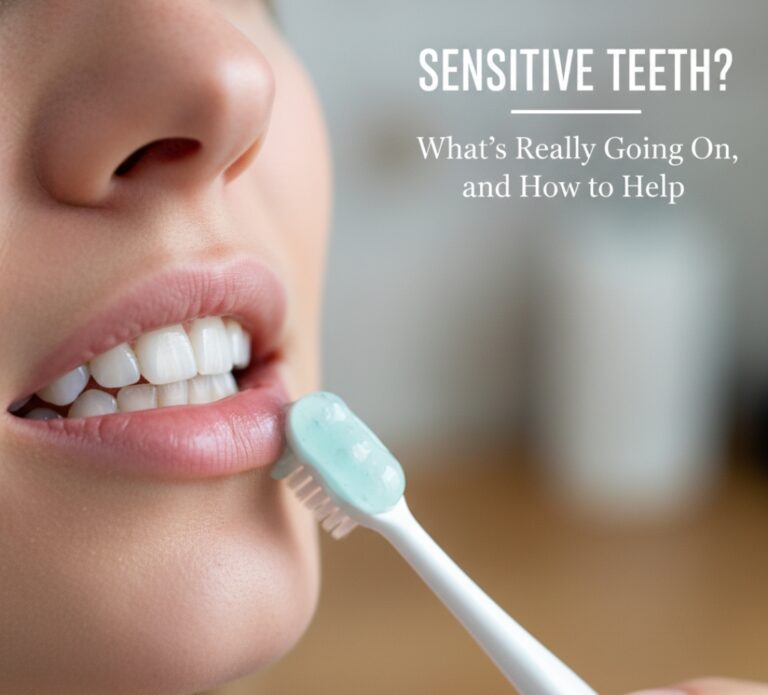If you’ve ever winced while sipping a cold drink or biting into ice cream, you’re not alone. Tooth sensitivity affects millions of people, and while it may seem like a minor inconvenience, it can be a sign of something deeper. For some, the discomfort comes and goes. For others, it lingers and impacts daily routines. Understanding why your teeth are reacting this way is key to finding long-term relief.
The first step is often talking with a cosmetic dentist in Belleville who can assess whether the issue stems from enamel wear, gum recession, or even habits you might not realize are harming your teeth. Sensitive teeth aren’t just about discomfort; they can also reveal early warning signs of underlying oral health issues.
This article explores what’s really happening when teeth become sensitive, the common triggers behind it, and what you can do to restore comfort and confidence in your smile.
1. Understanding Tooth Sensitivity: When Pain Is a Signal
Tooth sensitivity, also known as dentin hypersensitivity, happens when the inner layer of your tooth, called dentin, becomes exposed. Dentin contains tiny tubules that connect directly to the nerve inside the tooth. When it’s protected by healthy enamel or gum tissue, you don’t feel anything unusual. But once exposed, these nerve channels respond sharply to stimuli such as temperature changes, pressure, or acidity.
The Structure of a Tooth
Each tooth is made up of three main layers:
- Enamel: The hard, outer shell that shields the tooth from damage and bacteria.
- Dentin: The porous layer beneath the enamel that transmits sensations to the inner nerve.
- Pulp: The inner core containing blood vessels and nerves that keep the tooth alive.b
When enamel erodes or gums recede, dentin loses its protection, and the nerves beneath it become more vulnerable. That’s when simple acts like drinking cold water or brushing can send jolts of pain.
What Sensitivity Feels Like
Tooth sensitivity isn’t the same for everyone. Some describe it as a sharp, sudden pain that fades quickly. Others experience a dull, lingering ache. It might affect one tooth or several at once, and the triggers can vary:
- Cold drinks or foods
- Hot beverages like coffee or tea
- Sweet or acidic foods
- Brushing too hard or using whitening toothpaste
- Even breathing in cold air
While mild sensitivity may seem manageable, it’s often the body’s way of signaling a problem that shouldn’t be ignored.
2. Common Causes of Tooth Sensitivity
Tooth sensitivity doesn’t come from one single source, it’s usually the result of a combination of lifestyle habits, dental conditions, or natural changes over time. Understanding these causes can help you pinpoint what’s happening in your mouth and take proactive steps toward relief.
1. Enamel Erosion
Enamel is the hardest substance in the human body, but it’s not indestructible. Acidic foods, carbonated beverages, and certain medical conditions (like acid reflux) can wear it down gradually. Once it thins out, the dentin underneath becomes exposed.
Everyday examples of enamel erosion include:
- Drinking soda or fruit juices frequently
- Consuming citrus fruits without rinsing afterward
- Brushing immediately after eating acidic foods (which can spread the acid)
Over time, enamel loss is irreversible, it doesn’t grow back, but preventive measures and remineralization treatments can strengthen what remains.
2. Gum Recession
Receding gums are one of the most common culprits behind sensitivity. When the gum tissue pulls away from the teeth, it exposes the root surface, which lacks enamel entirely. The roots are covered by cementum, a much softer tissue that wears away easily under pressure.
Gum recession can result from:
- Aggressive brushing with hard-bristled toothbrushes
- Gum disease (periodontitis)
- Misaligned bite or teeth grinding
- Aging and genetics
Because gum tissue doesn’t regenerate naturally, treating recession early helps prevent worsening sensitivity and potential tooth loss.
3. Cracked or Chipped Teeth
A small fracture in a tooth can create a direct pathway to the dentin or pulp, allowing heat, cold, or bacteria to reach the nerve. Cracks can develop from biting hard foods, jaw clenching, or trauma.
Even a hairline fracture invisible to the naked eye can trigger sharp, localized pain. That’s why it’s essential to have persistent sensitivity evaluated by a dentist rather than assuming it’s normal.
4. Grinding and Clenching (Bruxism)
Chronic teeth grinding can wear away enamel faster than normal chewing. Many people grind unconsciously during sleep or when stressed. Over time, this friction flattens tooth surfaces, thins enamel, and exposes dentin.
Custom night guards can prevent further damage by cushioning your bite and distributing pressure evenly.
5. Whitening and Dental Procedures
Some whitening products, especially those with high peroxide concentrations, can temporarily irritate the dentin or nerve endings. Similarly, recent dental work like fillings, crowns, or cleanings can cause short-term sensitivity that usually resolves within a few weeks.
If sensitivity persists after a procedure, it might indicate a deeper issue, like an exposed nerve or an improperly sealed restoration, that needs professional attention.
3. How Everyday Habits Can Make Sensitivity Worse
Tooth sensitivity doesn’t always come from big dental problems. Sometimes, it’s the little things we do every day that slowly make it worse. The good news? Small changes can lead to significant improvements.
Overbrushing and Hard Bristles
Many people believe brushing harder means cleaner teeth. In reality, excessive pressure combined with stiff bristles can scrape away enamel and irritate gums. Instead, use a soft-bristled toothbrush and gentle circular motions.
Electric toothbrushes with pressure sensors can help train you to brush safely while still being effective.
Skipping Regular Cleanings
Plaque that hardens into tartar near the gumline can trigger inflammation, which contributes to gum recession and sensitivity. Regular cleanings remove this buildup and allow dentists to catch early signs of enamel wear before it becomes serious.
Poor Diet Choices
Acidic and sugary foods accelerate enamel erosion. Beverages like soda, energy drinks, and wine, even sparkling water, can all lower your mouth’s pH, softening enamel temporarily. Rinsing with water after consumption helps neutralize acids.
Ignoring Early Warning Signs
Many people adapt to mild sensitivity by chewing on one side or avoiding cold foods. This can lead to uneven wear and further gum recession. Addressing discomfort early prevents damage from escalating.
Stress and Bruxism
Clenching during stressful moments might seem harmless, but even short bouts of tension can increase wear on enamel. Learning to identify these triggers, and using relaxation or mouth guard techniques, helps preserve your teeth’s protective layer.
4. Managing and Treating Tooth Sensitivity
Fortunately, tooth sensitivity is manageable. Depending on its cause and severity, treatment can range from at-home care to professional dental procedures.
At-Home Solutions
- Desensitizing Toothpaste
These toothpastes contain active ingredients like potassium nitrate or stannous fluoride that block nerve signals in the tooth. It can take several weeks of consistent use before noticeable results appear. - Switch to a Soft Toothbrush
Replace medium or hard bristles with soft ones and use gentle pressure. Avoid horizontal scrubbing motions. - Fluoride Mouth Rinse
Fluoride strengthens enamel and helps remineralize weakened areas. Rinsing daily can reduce discomfort and increase resistance to acid attacks. - Avoid Whitening Products Temporarily
If whitening treatments cause irritation, take a break and switch to a gentle, low-peroxide formula under professional guidance. - Rinse With Salt Water
A mild saltwater rinse (½ teaspoon of salt in a glass of warm water) can soothe inflamed gums and reduce bacterial buildup.
Professional Treatments
If sensitivity persists or worsens, professional intervention may be necessary.
- Fluoride Varnish or Gel: Dentists can apply concentrated fluoride directly to sensitive areas to strengthen enamel and reduce nerve response.
- Bonding Agents: For exposed roots or worn enamel, a thin layer of bonding resin can seal the surface and block sensitivity.
- Gum Grafting: In cases of severe gum recession, soft tissue grafting can cover exposed roots, protecting them from further wear.
- Root Canal Therapy: If sensitivity is due to nerve damage or deep infection, a root canal may be required to remove the inflamed pulp and seal the tooth from inside.
Each of these options depends on your unique dental structure and the underlying cause of the discomfort, another reason why an in-person evaluation is crucial.
5. Preventing Sensitivity Before It Starts
Once sensitivity develops, managing it is possible, but preventing it is even better. Most causes of sensitive teeth are preventable with consistent care and mindful habits.
Focus on Protective Oral Care
- Brush twice a day with fluoride toothpaste.
- Floss daily to remove debris between teeth and along the gumline.
- Schedule professional cleanings every six months.
Regular dental checkups allow your dentist to monitor enamel health, gum position, and bite alignment before issues become painful.
Rethink Your Diet
Cut back on acidic beverages like soda, sports drinks, and citrus juices. If you do consume them, use a straw to minimize contact with teeth and rinse your mouth afterward.
Include foods rich in calcium and phosphate, such as cheese, leafy greens, and almonds, which naturally strengthen enamel.
Address Bruxism and Stress
Night guards can protect enamel from grinding during sleep. During the day, practice jaw awareness, unclench your teeth when relaxed and avoid chewing on non-food objects like pens.
Replace Toothbrushes Regularly
A worn-out toothbrush can damage gums and fail to remove plaque effectively. Replace it every three months or sooner if the bristles fray.
Monitor Changes Over Time
Sensitivity that appears suddenly or affects a single tooth might indicate a new cavity, cracked filling, or gum infection. Quick response often prevents more invasive treatments later.
The Takeaway: Listen to What Your Teeth Are Telling You
Tooth sensitivity isn’t just about fleeting discomfort, it’s a message from your body that something needs attention. Whether it’s thinning enamel, exposed roots, or an early cavity, these signals should never be ignored.
Your teeth, like any other part of your body, rely on daily care and professional support to stay strong. By understanding the causes and addressing them early, you can protect not only your comfort but also your long-term oral health.
And if sensitivity persists despite your best efforts, remember that solutions exist, from desensitizing treatments to protective restorations. With a proactive approach, you can enjoy your favorite foods, drinks, and moments again, without that familiar sting.
Disclaimer: This article is for general information only. It is not a substitute for professional dental advice. If you have tooth pain or sensitivity, please see a dentist for proper care.



